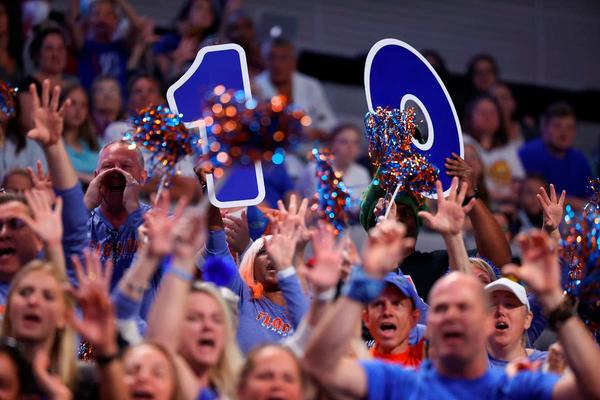NCAA gymnastics and the not-so-rare perfect 10

What college gymnasts achieve is nothing short of remarkable, but NCAA women’s gymnastics has seen dramatic increases in perfect 10s over the last few seasons. While perfection remained rare from 2018 to 2020, the 2022 season awarded double the perfect scores compared to previous years.
- The explosion also extends to near-perfection. Judges gave nearly twice as many 9.975s and 9.95s in 2022 compared to 2018.
And the 2023 season is already on track to match or exceed those numbers. Through February 14th, last season had notched 28 perfect 10s. This season, college gymnasts snatched 30 (!!!) before Valentine’s Day, sparking a lot of discussion across the gymternet.
What’s most confusing? Some of these routines — even ones that receive a 10 from at least one judge — have noticeable mistakes.
- One analysis of January’s 12 perfect scores found that nearly half did not rise to a perfect 10 level, leaving fans and athletes alike wondering if the idea of perfection still works if it’s been watered down.
For context, an NCAA gymnast’s score begins with the start value, which is 10 on most of the four events, in order to maximize their possible score. Points are then deducted for everything from falls to missteps and wobbles.
- Because college gymnastics is more focused on perfect execution than packing in heaps of difficult moves, routines tend to be high in both precision and very entertaining self-expression.
📚 An elite history of perfection
College gymnasts have been scoring 10s since the 1980s, but the first perfect scores hit mats in elite gymnastics. While NCAA gymnasts are the top-tier amateur contenders, elite tumblers compete one step above at the international level. And some, like Team USA’s Olympic medalists Sunisa Lee, Jordan Chiles and Jade Carey, do both.
Women’s elite gymnastics made its Olympic debut in 1928, but because perfection was considered unattainable, it was nearly 50 years before the first 10 showed up in competition.
- At the 1976 Montreal Games, Romanian Nadia Comăneci’s uneven bars routine scored the Olympics’ first-ever perfect 10. Fun fact: The scoring system flashed a 1.00 because it wasn’t even programmed for a score that high.
Comăneci’s performance threw the proverbial door wide open on perfect scores. Twelve years later at the 1988 Games, judges gave out a whopping 41 perfect 10s — and not all of them had flawless execution.
🤔 The controversy
While concerns of politically-motivated judging and blatant favoritism underscored elite competition for decades, it took a massive controversy in men’s gymnastics to shatter the idea of perfection.
- In the all-around competition at the 2004 Athens Olympics, Paul Hamm — Team USA’s most decorated male gymnast — finished his vault by falling onto the judges’ table, putting him in 12th place with two events left to compete.
- Hamm wound up winning all-around gold, but it was later ruled that a judging error occurred. South Korean bronze medalist Yang Tae-young mistakenly received a start value of 9.9 instead of the full 10 (the degree of difficulty) on his parallel bars routine, which cost him owning the podium.
Hamm’s medal was contested all the way to the Court of Arbitration for Sport where it was upheld. But the controversy saw three judges suspended and, more importantly, ushered in a new era of gymnastics scoring where perfection is impossible.
↔️ The scoring shift
Hamm’s victory renewed calls to address favoritism in judging so, much like elite figure skating’s 2004 shift from a perfect score system to one based on more mathematical criteria, the International Gymnastics Federation (known as the FIG) instituted the Code of Points in 2006.
Elite gymnasts are now scored by two separate judges panels. One group evaluates execution and the other assesses difficulty. These scores are then added together to determine a competitor’s event score.
- Execution is still scored out of 10 points and functions exactly like the original system, where deductions are taken for each imperfect move.
- Difficulty, however, functions as an assessment of a routine’s skills. The more extreme the skills, the higher the difficulty score. There’s no upper limit on this metric, meaning much like the GOAT Simone Biles, the limit — and perfection — does not exist.
🤸♀️ The challenge
Much like elite gymnastics, college contenders are now voicing similar scoring concerns. Favoritism from judges, particularly toward previous NCAA champs, is a not-so-secret factor on scoresheets. But, given the recent deluge of 10s, how should college gymnastics address the concerns?
While the most obvious option is to take a page from the international stage and institute a system where perfection is impossible, such a move would completely shift the collegiate sport’s culture. Increased focus on difficult skills would mean less joyful expression (and mad dance moves) in order to pack routines with tougher tumbles.
Instead, the first step may be to simply send collegiate judges, ahem, back to school. If those evaluating received better or more frequent training, both in scoring and in bias, perhaps they would let fewer hops and wobbles slide. Perfect 10s, then, could again be the rare gymnastics gems that they’re supposed to be.
Enjoying this article? Want more?

Sign up for The GIST and receive the latest sports news straight to your inbox three times a week.